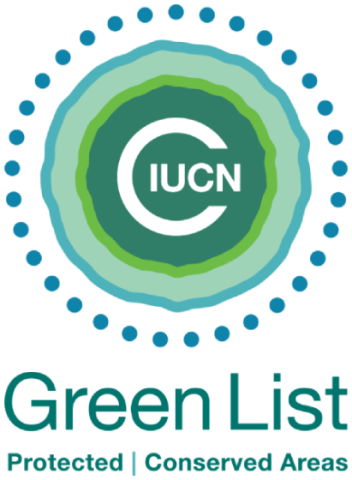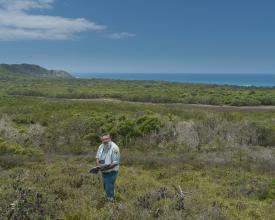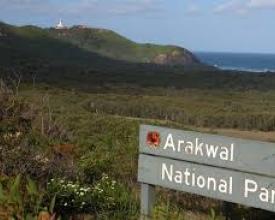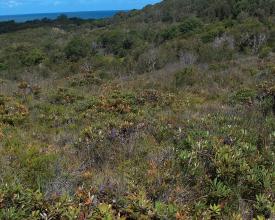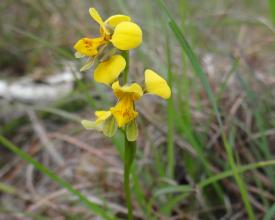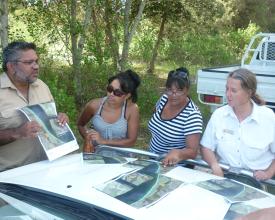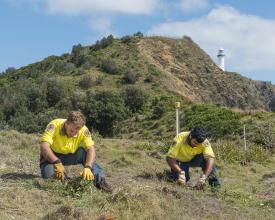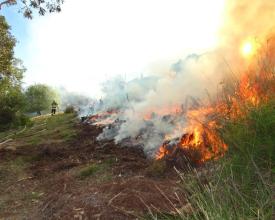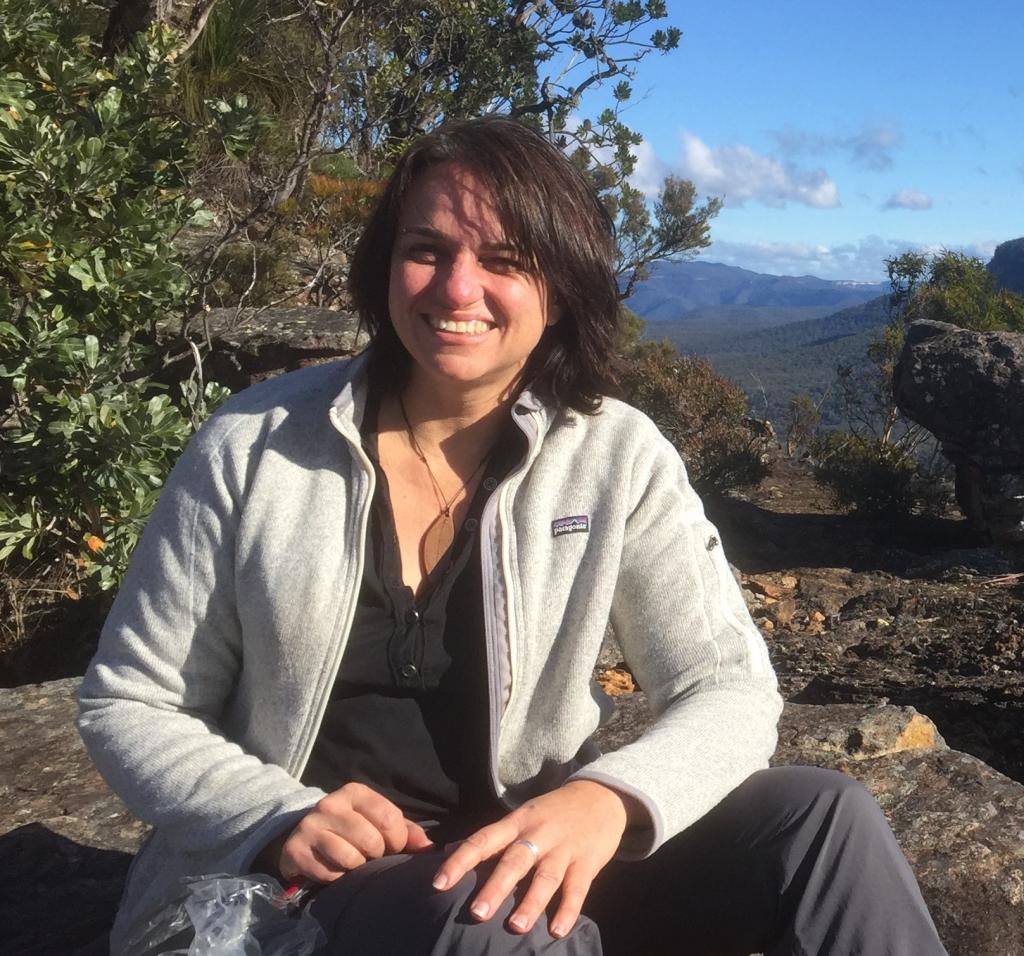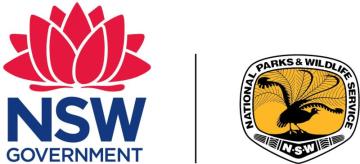
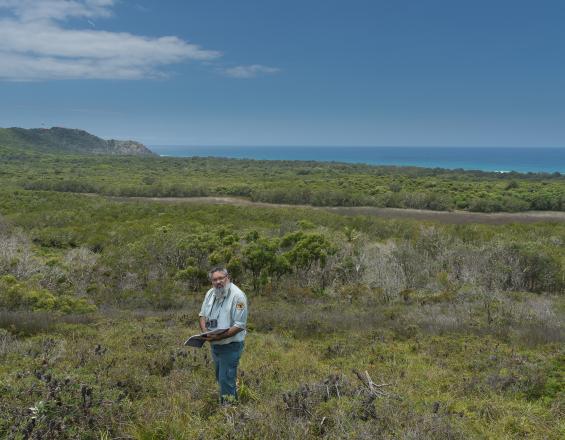
Arakwal National Park (NP) is a small coastal reserve in New South Wales that was created in 2001. An Indigenous Land Use Agreement formally recognises the Bundjalung People of Byron Bay (Arakwal people) as the Traditional Owners and provides for joint management with the NSW National Parks and Wildlife Service (NPWS).
Although Arakwal NP is small, it contains significant cultural and ecological values including the endemic Byron Bay Graminoid Clay Health community - the only known habitat of the endangered Byron Bay Orchid (Diuris byronensis).
This species is important to the Arakwal people and is the focus for a renewed cross-cultural approach to management. NPWS managers, Arakwal rangers, Traditional Owners and scientists have been working to incorporate Indigenous and scientific knowledge and cultural priorities in management decisions for the orchid and clay heath community. In 2018 a cultural burn of the orchid’s heath habitat was done – the first in 30 years. Already there are signs of successful regeneration.
Context
Challenges addressed
Arakwal people were at risk of losing their knowledge of, and connection with, the clay heath as many people had moved away and the focus was on other accessible areas such as Tallow Creek. Significant time and effort are required to bring people onto Country and give them the opportunity to reconnect with Country and each other, retelling important stories.
The challenge is urgent since there is a risk that the Graminoid Clay Heath and Byron Bay orchid will become extinct. Just a few hectares of clay heath remain and just a few individuals of the orchid have been recorded in recent years. In preserving this habitat and species there is a need to think beyond the species and to consider cultural connections for management to be successful.
Undertaking the cultural burn was very challenging as the clay heath is very close to urban communities, orchids had to be protected from direct fire and the burn had to be done in a cultural way.
Location
Process
Summary of the process
While the Arakwal people and NPWS have already established a strong and successful partnership over many years this process made it clear that the views, knowledge and culture of Arakwal people were intended to be brought to the forefront of decision making. Ensuring the best available knowledge -both cultural and western science - was used ensured the best chance of achieving cultural and ecological outcomes. The commitment of NPWS managers and Arakwal people to undertake the identified actions in a culturally appropriate way and monitor the results meant Arakwal people are able to look after the endangered clay heath and the orchid and demonstrate the value of these approaches to Arakwal people, NPWS and the community.
Building Blocks
PARK MANAGERS AND TRADITIONAL OWNERS AGREE HOW TO WORK TOGETHER
The principles and ethics of applying a cross-cultural approach were established at the outset. It was important that this was an Arakwal led process and they had a strong voice in setting up the collaboration framework. This included who the knowledge holders were, how information could be shared within the Arakwal community, within the joint management team and with the wider non-Aboriginal community, who had a say in prioritising values, how to engage the Arakwal and broader Byron Bay communities and the time frame that suited all participants. Arakwal rangers, Arakwal community, researchers and NPWS managers collaborated to identify a vision and shared purpose through a series of workshops. Together they developed the vision for the orchid and surrounding habitat, "this species and place is in healthy condition into the future, and that the areas and its values are cared for, learned about and used by the Arakwal people”.
Enabling factors
Everyone was committed to the project and was open to new ideas and insights. Park managers, Arakwal rangers and Arakwal community were open to examining the ways they had been working together and working with others to enhance what was already a very successful program. A key factor in the success of this project was working in collaboration with researchers from CSIRO who had applied similar approaches with Indigenous communities elsewhere in Australia successfully.
Lesson learned
Even though Arakwal NP governance and joint-management arrangements were already very strong and successful, there was opportunity to use new ways to enhance collaboration. Taking time to articulate and discuss principles and ethics provided the foundation for openness and collaboration and an understanding of the right way to do the rest of the project. There are many ways that Indigenous views and knowledge can be incorporated with science and management, depending on the situation, so it was important to use the approach that worked in this case.
DEVELOP A COMMON UNDERSTANDING OF THE MOST IMPORTANT VALUES AND HOW TO LOOK AFTER THEM
Through the three workshops, Arakwal knowledge holders had time to identify, discuss and build consent on the priority values, most important actions and how to evaluate success.
Through this process, protecting and caring for the Byron Bay orchid and its habitat, the graminoid clay heath were identified as the highest priority for management. Both have cross-cultural significance as they have cultural significance for Arakwal people and are listed as endangered under Australian Environmental Protection and Biodiversity Conservation Act 1999. NPWS and Arakwal people are working to protect these values but are faced with challenges of limited resources and information.
Ten key actions were identified to help manage the cultural and ecological values of the orchid and its habitat including: activities to bring people on country, management of weeds and encroaching trees in the clay heath habitat, harvesting of seeds and fruits, communication to reduce impacts of neighbours and visitors. One of the most important actions identified was to undertake a cultural burn in the heath which requires burning to regenerate and control weeds and invasive plants. Cultural burning is defined as “burning practices developed by Aboriginal people to enhance the health of the land and its people” (Firesticks Alliance Indigenous Corporation).
Enabling factors
Using the IUCN Green List Standard provided an opportunity to look at the ways of identifying values, prioritising actions and evaluating success. The workshops were held over many months providing time for everyone to bring relevant knowledge and also reflect on the outcomes of the previous workshop. The prioritisation method ranked actions by how beneficial they would be and how many resources were required for implementation. This meant that the most beneficial actions were prioritised even if they required a lot of resources.
Lesson learned
To ensure genuine cross-cultural input it was important to define values and priorities based on Arakwal leadership from the outset.
COMMIT TO IMPLEMENT AGREED ACTIONS THE ‘RIGHT’ WAY AND EVALUATE THE IMPACT
The Arakwal people and NPWS staff committed to work together to implement the agreed actions. NPWS included actions in the annual operations plan and worked with Arakwal people to create opportunities for them to connect with the orchid and its heath habitat. They recognised this as an important part of maintaining and strengthening the cultural values. Before this project, the heath had not been burned for 30 years due to the difficulty of getting approval for a cultural burn of bushland next to a suburban area. Even though the cultural burn required a lot of resources, NPWS prepared and approved a burn plan and Arakwal people undertook cultural activities such as seed collection ahead of the fire. Fortunately, in 2018 all the conditions were suitable for a small cultural burn. The health of the heath has been surveyed by Arakwal NPWS staff post fire with additional sightings of Byron Bay orchid have been reported.
As a result of this project a seasonal planning calendar which highlights how management actions are scheduled through year, factoring in seasons, opportunities, weather and traditional practices was co-created. The calendar brings together culture, ecology and management actions in an easy to understand form that is both a communication and a scheduling tool.
Enabling factors
Arakwal people and NPWS worked together to prioritise and undertake both cultural and ecological management activities with relatively small amounts of additional funding. Arakwal people were not constrained in what the money could be spent on as long as it was to support implementation which meant that cultural activities and bringing community members on Country could occur.
Lesson learned
Everyone involved in the project realised the importance of celebrating success as a way to inspire the whole team and to realise the value of monitoring. Celebrating success led to people looking for ways to improve and to look to the future and new opportunities.
By using a new method to review priority actions through a cultural lens, the Arakwal NP Plan of Management was examined anew which refocussed management actions to protect and restore the cultural and ecological health of the clay heath.
Impacts
The Arakwal people have a connection with their lands and waters dating back at least 22,000 years. The ecological and cultural values of Arakwal NP are inseparable due to the strong cultural association of the Arakwal people with the area and their knowledge and use of plants and animals. Joint management has had positive outcomes for conservation, Arakwal culture, and local communities
Since 2016, Arakwal people, NPWS and CSIRO have been working together using cross-cultural approaches to identify the most important actions to rehabilitate the orchid’s habitat. These included bringing people on country, managing weeds and encroaching trees, harvesting bush tucker, communicating with neighbours and visitors, maintaining tracks and importantly, a cultural burn in the orchid habitat. These actions have been progressively implemented by park managers with the support and participation of Arakwal people. A seasonal planning calendar was developed to show how management actions are scheduled considering seasons, opportunities, weather and traditional practices.
Through this process, local Arakwal communities have had more opportunities to connect with Country, share knowledge and strengthen relationships. Arakwal rangers and community have had a stronger voice in decision making about how to care for Arakwal NP.
Beneficiaries
- Arakwal people
- Local community
- NSW National Parks and Wildlife Service
- Commonwealth Scientific and Industrial Research Organisation
- Threatened plant species and communities of Byron Bay
Sustainable Development Goals
Story
The Bundjalung People of Byron Bay (Arakwal people) are leaders in management of traditional lands for cultural and conservation values and have achieved a series of firsts at local, national and international levels. Arakwal NP was the first national park in NSW created under an Indigenous Land Use Agreement that recognises Arakwal people as Traditional Owners. The international significance of this landmark agreement was recognised by IUCN Fred M. Packard Award in at the 5th World Parks Congress in South Africa.
In 2014 Arakwal National Park was the first protected area in the world to be included on the IUCN Green List of Protected and Conserved Areas (IUCN Green List) recognising the outstanding efforts of staff and managers to achieve effective and equitable management.
The collaboration between researchers, Arakwal people and NPWS provided the opportunity to focus on cultural priorities, for Arakwal community to spend more time on Country, with each other and strengthen their connection to the clay heath areas.
Senior Arakwal Traditional Owners have shared their perspectives on the benefits to Arakwal people.
“We worked together to build the knowledge, agree on the actions and assess how we want to care for the Byron Bay orchid and our Country.” Norm Graham, Senior Arakwal Traditional Owner and NPWS Ranger
“The ‘Threatened Species Recovery Hub Cross-cultural approaches with Arakwal people on protecting the Byron Bay orchid and its habitat’ project was an inspirational partnership. As Arakwal partners we understand about caring for Country and through this project our cultural knowledge and science was woven together to protect the orchid and its home. The highlights are we were given a real opportunity to lead with mutual respect of cultural protocols and meaningful time to discuss innovative solutions. The project empowered us to create resources and ongoing research to protect the orchid’s future.” Delta Kay, Arakwal Education Officer and Norm Graham, Arakwal Ranger, NSW National Parks and Wildlife Service.
In 2019 Arakwal NP was renominated for the IUCN Green List. Also in that year, and continuing the tradition of ‘firsts’, the CSIRO Team, Arakwal Traditional Owners and joint managers of Arakwal National Park were awarded the inaugural CSIRO medal for Aboriginal and Torres Strait Islander Engagement for their exceptional quality of cross-cultural engagement on protecting the critically endangered orchid and its habitat.
